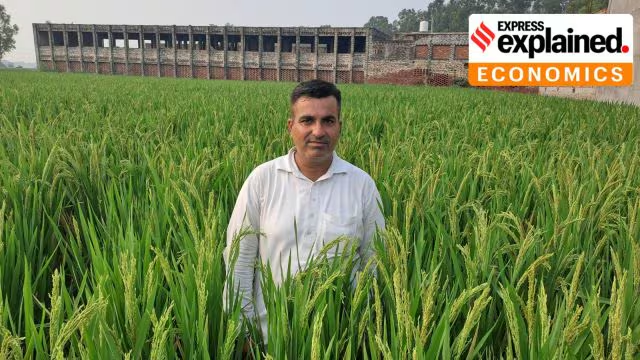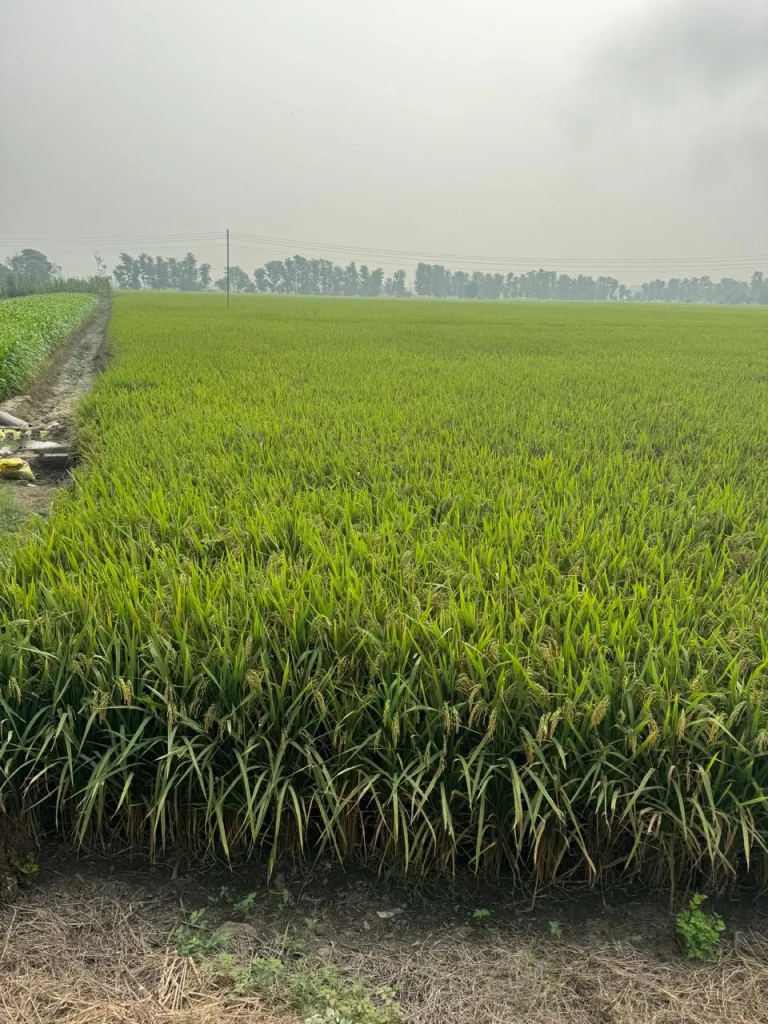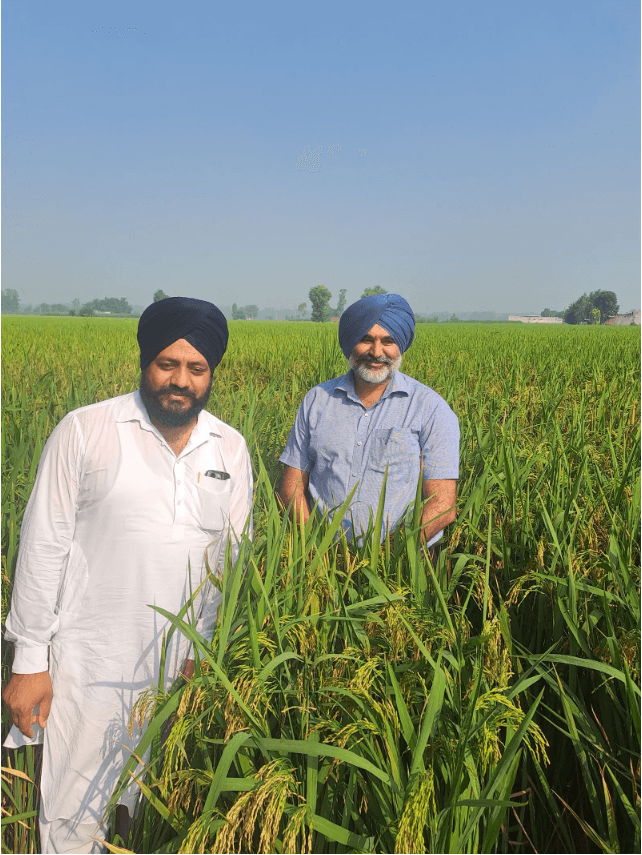Tags
A rice variety that can address farm fires in Punjab and Haryana: here’s how
The narrow window between paddy harvesting and sowing of wheat is at the root of farm fires in Punjab and Haryana. Here’s why that happens, and how a new rice variety could help.
Written by Harish Damodaran

Harpreet Singh has been cultivating Pusa-44 paddy since 2000, if not earlier. “Why not, when it yields 35-36 quintals grain per acre, and even 40 quintals in some of my land?,” the 39-year-old from Bourhai Kalan village in Punjab’s Malerkotla district remarked.
Bred by the Indian Agricultural Research Institute (IARI) at New Delhi, and released for large-scale cultivation in 1993, Pusa-44 takes 155-160 days to grow, from the time of sowing its seeds in nurseries to harvesting the grain.
The high yields — more than the 30-32 quintals per acre that its nearest competitor, the Punjab Agricultural University’s PR-126, gives over just 123-125 days — is Pusa-44’s main attraction for farmers. Although taking 30-35 days longer to mature, the extra 4-5 quintals yield is worth Rs 9,280-11,600 (per acre) at the Centre’s minimum support price of Rs 2,320 per quintal for ‘Grade A’ paddy.
Pusa-44’s environmental cost
But there is a cost to the high yields. The Pusa-44 paddy, transplanted in mid-June after nursery-sowing a month before, can be harvested only towards end-October. This leaves little time for field preparation to sow the winter wheat crop, which should ideally be done before mid-November. Most farmers, then, resort to burning the loose straw and standing stubble that remains after harvesting using combines.
The narrow turnaround window between paddy harvesting and the optimal sowing of wheat is at the root of farm fires in Punjab and Haryana — and the severe air pollution it contributes to in much of northern India — from late-October to mid-November.

The problem is more with the cultivation of Pusa-44, which covered an estimated 14.8% of Punjab’s total non-basmati paddy area in 2023. That was lower than the 22% of 2022 and 39% in 2012, and even PR-126’s 33% share last year. Yet, it remains the farmer’s first choice, especially in the south-central districts of Sangrur, Malerkotla, Barnala, Ludhiana and Moga. While the Punjab government has banned Pusa-44 from this crop year, with the IARI also not supplying breeder material for further multiplication after 2021, farmers are still growing it — using saved grains from the previous crops as seed.
In the current season, Harpreet Singh has sown Pusa-44 on 90 out of his 100-acre holding, transplanting these between June 10 and June 24 for harvesting from around October 20 to November 2. Singh does not burn the stubble: “I plough it into the soil using a Super Seeder, which also sows the wheat seeds in a single pass”.
Not all farmers, though, can afford such expensive tractor-drawn machines. For them, stubble burning remains the least costly and most time-saving option to clear their fields.
Pusa-2090: A viable replacement?
IARI has bred a new improved shorter-duration variety, Pusa-2090.
A selection from a cross between Pusa-44 and CB-501, an early-maturing Japonica rice line, it has a seed-to-grain maturity of 120-125 days. That’s the same as PR-126, but Pusa-2090’s paddy yield of 34-35 quintals per acre — now being tested in farmers’ fields — is closer to Pusa-44’s.
Agricultural scientists have, for long, worked at introducing genes from Japonica (a rice subspecies of East Asia) to the Indica varieties (grown in India and other tropical/subtropical regions) for improving yields and disease resistance. In this case, CB-501 was identified as a male parent line primarily for contributing to earliness (50% of its plants flower in 80 days, as against 120 days for Pusa-44). The resultant cross, thus, combined Pusa-44’s high yields with CB-501’s lower duration.“Yields are a function of the number of tillers (branches with grain-bearing ear-heads or panicles) that each plant produces; the number of grains per panicle; and the weight of every 100 grains. The number of tillers per plant and filled grains per panicle are roughly the same in Pusa-44 and Pusa-2090 (around 30 and 260 respectively), while more than that for PR-126 (20 and 200),” A K Singh, former director of IARI, told The Indian Express.
Given the lower yield penalty vis-à-vis Pusa-44, and duration comparable to PR-126, farmers may find it viable to cultivate Pusa-2090. The new variety also has a strong culm (main stem) that makes it less prone to lodging (bending over or falling due to heavy winds and rains) than PR-126. It is highly responsive to the application of nitrogen (urea), again a trait shared with Pusa-44. And its maturing some 35 days earlier translates into significant water savings, with at least 5-6 less irrigations required against the normal 29-30 for Pusa-44.
What farmers think
Harpreet Singh last year planted Pusa-44 on 90 and PR-126 on 10 acres. This time, he has grown Pusa-2090 in place of PR-126 on the same 10 acres.
“I sowed my nursery on June 2 and transplanted on June 28-July 2. As of now, I am expecting a grain yield of 35 quintals, but we will really know only after the crop is harvested by October 4-5 and weighed,” Singh said.
Harvesting paddy in early-October should give Singh plenty of time to sow wheat. But he plans to plant potato instead; the ‘Diamond’ variety sown in mid-October would be ready for harvesting by mid-February. “After that, I will immediately plant Dekalb-9108 (a maize hybrid) for harvesting in 80-85 days towards mid-May,” he added. Farmers wanting to only take wheat after paddy can transplant Pusa-2090 even in mid-July.

Sukhjeet Singh Bhangu, a farmer with 20 acres of land in Kanakwal Bhanguan village of Sangrur’s Sunam tehsil who also grows and markets seeds under his ‘A-One’ brand, felt that Pusa-2090 may replace Pusa-44 in the areas where it still dominant: “Most farmers will hesitate growing a banned variety, for fear of it not being procured by government agencies. If Pusa-2090 gives 34-35 quintals, which is almost as much as Pusa-44 and above PR-126, they would go for it”.
Vikas Chaudhary, a seed grower from Taraori village in Nilokheri tehsil of Haryana’s Karnal district, harvested 35 quintals of paddy from his one-acre trial plot under Pusa-2090 last year: “That was good, as the grains had only 13% moisture (against the normal 16-17% content). This year’s crop (nursery-sown on June 6 and transplanted on July 6) should also yield around that level”.
Farm yields apart, there is also the issue of milling quality. “PR-126 paddy isn’t liked much by millers because the rice recovery from it is hardly 63%, whereas the government’s required norm is 67%. If Pusa-2090’s grain quality matches that of Pusa-44, there will be acceptability for it from the millers’ side too,” Bhagwan Dass, secretary-general of the Rakhra (Patiala)-based Young Farmers Association Punjab, pointed out.
https://indianexpress.com/article/explained/explained-economics/pusa-44-rice-punjab-haryana-stubble-9594896/Published Date: September 30, 2024






